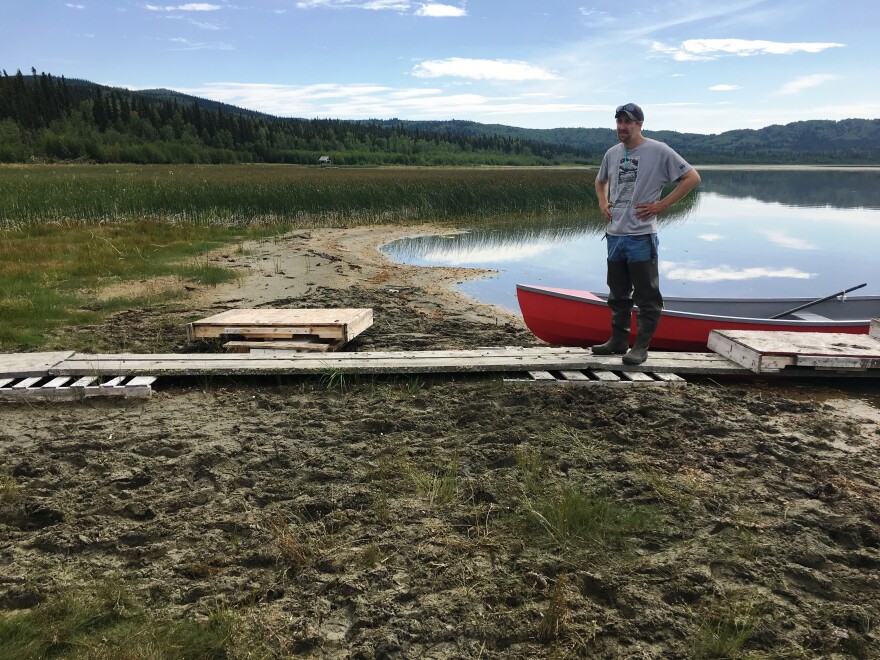Quartz Lake is shrinking -- the water level of the popular lake just north of Delta Junction is dropping. And while researchers try to find out why, archeologists are studying how humans have adapted to the lake’s periodic cycles of rising and falling water levels since they moved into the area 14,000 years ago.
Josh Reuther navigates his small boat out into Quartz Lake en route to the eastern shore to drop off his friend, Wendell Shiffler, at his cabin on land he bought in 1972. That’s when the lake, which has no surface-water inlet or outlet, was about 1,500 acres. Shiffler says he’s seen a lot of changes over the past few decades.
“That’s where I docked the boat, when we first got here,” Shiffler said, pointing at the wooden platform that now sits on mostly dry ground, covered with grass. “So, you can see, this has gotten shallow. And the lake has gone down just in the last couple of weeks – the water’s dropped, a little bit.”
Shiffler is a retired high school science teacher who lives in Fairbanks when he’s not at his getaway cabin. He says the shoreline has receded as the lake’s water level has dropped, and enlarged his parcel from 2.5 to 3 acres. It also required him to extend his boat dock another 50 feet or so to get into water that’s at least knee-high, deep enough to keep small boats from running aground.
He says some of the other 50 or so people who own cabins around the lake have had to do the same thing.

“When people ask me, property owners, say ‘What are we going to do about the lake going down? What can you do?’ Well,” he said, “we adapt – that’s right. And so I built another section of dock, out a little bit further.”
Human adaptation to changes in the lake is what Reuther and his fellow researchers have been studying. Though, they’re looking farther back, at how humans who’ve inhabited the area over the milennia have changed their diet in response to the lake’s periodically changing water level.
“It’s risen and fallen over the past 9,000 years, just continually,” he said.
Reuther’s an assistant Anthropology professor at UAF and curator of Archaeology at the Museum of the North. He and other researchers have for 10 years now been exccliavating sites around the lake, looking for clues on how humans have found other sources of food because of the water-level changes. He points to one site just offshore in shallow water near an old dock he tied up his boat at on the northern end of the lake, where archeologists have found such artifacts as European trade beads and some stone tools.

“We radiocarbon-dated the thing, so we knew they were (present) within the last 150 years,” he said. “... So we’re thinking it’s about 1840 to 1860 is when people were on this shoreline, when it was down.”
Reuther says bits of bones and other evidence show moose were slaughtered at the site. He says that suggests they were killed while grazing on a type of grass that grows in shallow water, preferred by moose and other big game, including the bison and elk that lived here some 5,000 years ago.
He says the animals move on as the area dries up and alder and willow overtake the grasses.
“Then these shrubs come in and take over these grasses,” he said. “That’s actually taking over feed for grazers like bison.”
A bit farther up the slope, a team of students and instructors looks for more evidence of adaptation. One of them is Bree Doering, a doctoral student from the University of Michigan. She’s working on a dissertation on why early inhabitants apparently turned to fish as a protein source some 1,500 years ago, when a volcanic eruption blanketed the area in ash.

“Is that related to this sort of climactic change that we see was associated with this volcanic eruption?” she asked. “Potentially a big caribou die-off in this area or in the Yukon? Did that make people turn toward fish as a more important resource? Or were people just attracted to it for other reasons?”
During a coffee break in the cabin next to the dig, Reuther says it’s important to study how humans have responded to climate change driven by the forces of nature over a geologic time scale. Because he says it might inform our understanding of changes that are occurring during a time of accelerated climate change triggered by human activity.
“Whether you have global warming or whatever, the ecology is going to change either way. It’s always in flux,” he said. “And when something changes, we want to know how humans are changing themselves, how they’re responding to that change.”
Reuther hypothesizes that the warming climate is thawing permafrost more deeply in the Shaw Creek Flats, an expanse of wetlands just north of Quartz. He says that draws water from the lake toward the Tanana River to the west. And he says warmer temperatures increase evaporation. Others say a decline in the area’s beaver population due to excessive trapping has led to fewer beaver dams being built in the flats, which would slow the movement of water from the lake.
But so far there’s no study on how modern-day humans are adapting to the many changes – besides building a longer dock.



